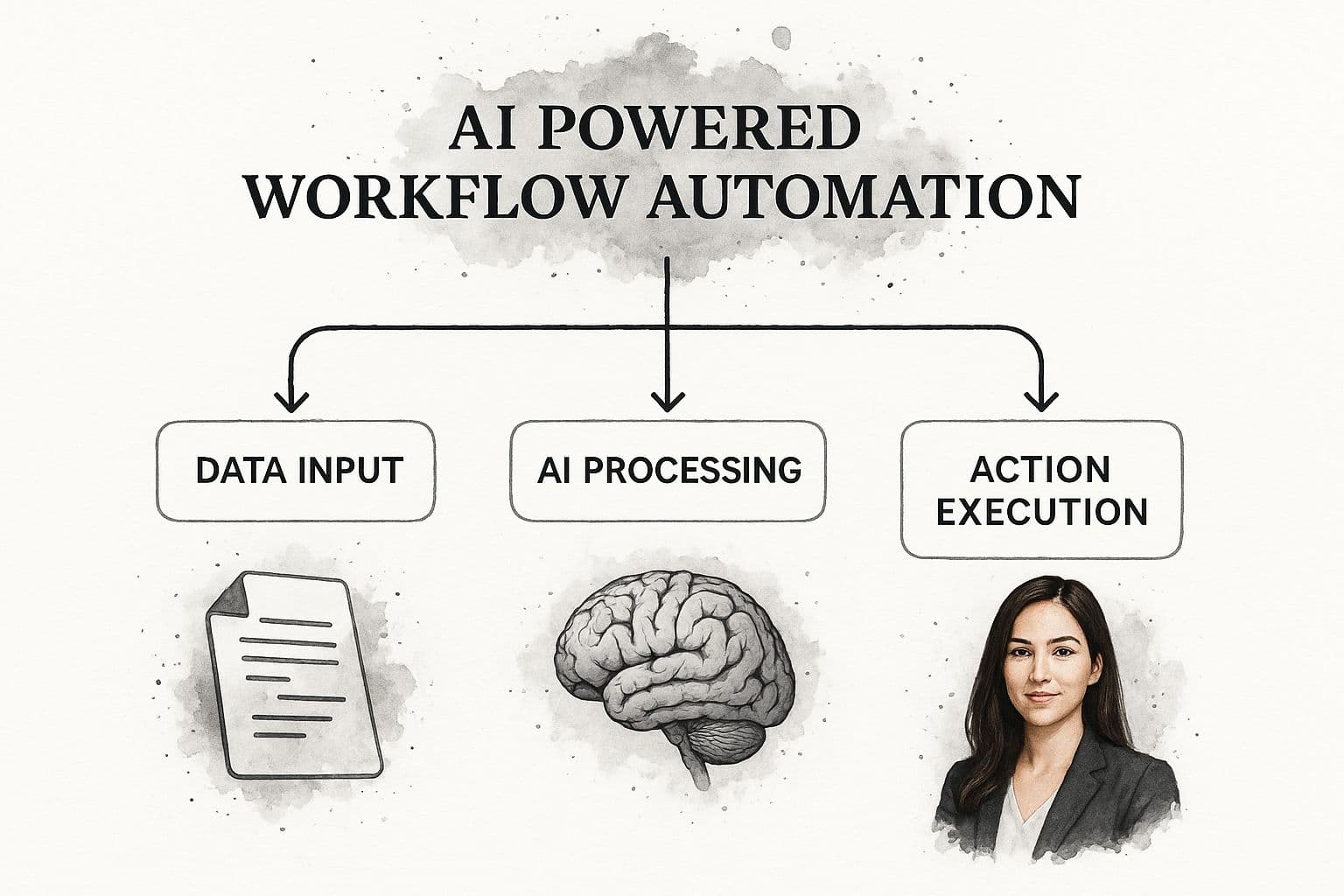Unlock peak efficiency with AI powered workflow automation. This guide explains what it is, its benefits, real-world examples, and how to implement it.
August 3, 2025 (4mo ago)
AI Powered Workflow Automation Explainer Guide
Unlock peak efficiency with AI powered workflow automation. This guide explains what it is, its benefits, real-world examples, and how to implement it.
← Back to blog
When you hear "workflow automation," you might think of simple, repetitive tasks being done automatically. But what happens when you add artificial intelligence to the mix? The result is something far more powerful. AI-powered workflow automation** doesn't just perform tasks; it learns, adapts, and improves them over time. It elevates standard automation from a basic "if this, then that" command into a dynamic system that can think for itself.
What Is AI-Powered Workflow Automation?
Let's use an analogy. Traditional automation is like a factory robot programmed to perform one specific motion perfectly, over and over. It's incredibly efficient for predictable, unchanging jobs.
AI-powered workflow automation, on the other hand, is like giving that robot a brain and a set of eyes. Now, it can spot defects on the assembly line, adjust its grip for different-sized objects, and even figure out how to do its job faster by analyzing its own performance. That's the difference—intelligence.
Where standard automation hits a wall with anything unexpected, its AI-driven counterpart thrives on it. It can understand unstructured data (like emails or customer feedback), handle variations in a process, and make smart predictions. For a solid foundation on the basics, you can explore our guide on https://fluidwave.com/blog/what-is-workflow-automation. The addition of this intelligent layer is what turns a simple calendar reminder into a system that actively helps your business grow.
The Core Components of Intelligent Automation
At its core, this technology works in a three-stage cycle: input, processing, and execution. But with AI, each stage is smarter, creating a feedback loop that continuously refines the entire process.
This diagram illustrates the flow:

As you can see, the system takes in raw information, uses its AI brain to analyze it and decide on the best course of action, and then executes that action. It's a simple-looking but incredibly potent cycle of learning and doing.
This capability isn't just a concept; it's driving massive market growth. The global workflow automation market, currently valued at USD 21.51 billion, is expected to soar past USD 37.45 billion by 2030. This rapid expansion shows just how much businesses are counting on AI to streamline their operations and stay ahead of the curve. If you're looking for a bird's-eye view, this comprehensive guide on AI workflow automation is an excellent resource.
AI doesn't just automate tasks; it automates decision-making. It can analyze incoming sales data, identify high-potential leads, and route them to the best-suited team member with tailored follow-up actions—all without human intervention. This shift from task execution to intelligent action is the true power of AI in workflows.
Understanding the Core AI Technologies

To really get a handle on AI-powered workflow automation, it helps to peek under the hood at the technologies doing the heavy lifting. Think of it like a specialist crew working on a project—each member has a unique skill, but when they work together, they can achieve something far more impressive than any one of them could alone.
The main players here are Machine Learning, Natural Language Processing, and Robotic Process Automation. Together, they form the engine that drives truly intelligent workflows. Each one tackles a different part of the puzzle, from learning and decision-making to understanding human language and executing tasks.
Let's break down these foundational pieces to see what they do and how they fit together to make your business run smarter.
Machine Learning: The Brains of the Operation
Machine Learning (ML) is the intelligent core of the entire system. It’s what gives a workflow the ability to learn from data, spot patterns, and make smart decisions without needing a human to hard-code every single rule.
Instead of just following a strict, pre-set script, an ML model sifts through historical information—like old project schedules, sales data, or customer service tickets—to figure out what works. For example, it can learn to predict which sales leads are most likely to close or flag a support ticket as urgent based on the language used. This predictive power is what allows AI-powered workflow automation to be proactive, not just reactive.
At its heart, Machine Learning gives automation a dose of foresight. A system with ML doesn't just process an invoice; it can flag that invoice as a potential duplicate payment because it has learned what fraudulent or erroneous submissions look like from thousands of past examples.
Natural Language Processing: The Universal Translator
If ML is the brain, then Natural Language Processing (NLP) is the system's ears and voice. NLP is the technology that allows software to actually read, comprehend, and interpret human language from all sorts of places.
This is a game-changer because so much of the information flowing into a business is messy, unstructured text. Here’s where NLP shines:
- Customer Emails: It can scan incoming messages, figure out the sentiment (Is this person happy or furious?), and automatically send the email to the right person or department.
- Support Tickets: NLP can pull key details from a customer’s description of a problem, saving an agent the time of manually entering that information.
- Internal Documents: The system can even read your company's standard operating procedures (SOPs) to help build and fine-tune an automated process on its own.
Robotic Process Automation: The Digital Workforce
Finally, Robotic Process Automation (RPA) acts as the "digital hands" of the operation, carrying out the actual tasks. At its core, RPA involves software "bots" that mimic human actions to get rule-based digital work done. Think of actions like logging into an app, copying and pasting data between spreadsheets, filling in forms, or moving files.
On its own, traditional RPA is great for those mind-numbing, repetitive tasks. But it becomes incredibly powerful when you pair it with ML and NLP. The AI components do the thinking and understanding, and the RPA bots execute the commands. It’s this combination that lets you automate sophisticated, end-to-end processes that require both smart decisions and action.
How Automation Transforms Your Business

Bringing AI-powered workflow automation into your company isn't just about speeding up the old to-do list. It's a fundamental shift in how your business operates, competes, and grows. The real magic happens when you swap out manual friction for intelligent, automated processes, leading to concrete business results. You move from putting out fires to preventing them, building a far more resilient and dynamic organization.
This shift delivers a serious competitive edge. It's why workflow automation is now a critical investment for roughly 75% of businesses and why the global market is expected to hit an estimated USD 18.45 billion. You can discover more key statistics and insights for success on this trend over at PointStar Consulting.
Let's break down the core areas where this change really comes to life.
Unleash Workforce Productivity
One of the first things you'll notice is a major jump in productivity. But this isn't simply about getting more done. It’s about freeing your most valuable people from the daily grind of repetitive, low-impact tasks.
Think about it. When your experts are no longer bogged down by manual data entry, pulling reports, or sifting through endless emails, their focus changes entirely. They can finally dedicate their brainpower to strategic planning, innovation, and creative problem-solving—the exact work that pushes your business forward. They go from being task-doers to strategic thinkers.
Drastically Reduce Operational Costs
Manual processes aren't just slow; they're expensive and full of risk. A single misplaced decimal or a misread invoice can spiral into costly rework, unhappy customers, and compliance headaches.
AI automation tackles this head-on by building consistency and precision right into the workflow.
- Error Elimination: The system performs tasks with machine accuracy, dramatically cutting the financial losses caused by human error.
- Resource Optimization: Automating processes means you spend fewer hours—and less money—on manual oversight and fixing mistakes.
- Proactive Prevention: AI can spot patterns to predict and flag potential issues before they turn into expensive problems.
The result is a leaner, more efficient operation where your resources are fueling growth, not just patching up holes.
Drive Smarter Decision-Making
We're drowning in data, but the real challenge is turning it into something useful. This is where AI automation shines. It can analyze massive datasets in real time, pulling out actionable insights a human could never find on their own.
Instead of running on gut feelings or stale reports, leaders can make calls based on live, data-backed intelligence. The system can identify emerging market trends, forecast demand, and pinpoint operational bottlenecks, giving you a crystal-clear view of the entire business.
This capability changes decision-making from a reactive, backward-looking exercise into a strategic advantage.
Achieve Effortless Scalability
Finally, AI-powered automation gives you a clear runway for growth. As your business expands, you can increase your output without having to proportionally increase your headcount or overhead costs. The automated systems handle the growing volume of work smoothly, allowing your company to scale efficiently and sustainably.
Real-World Examples of AI Automation

The theory behind AI-powered automation is one thing, but seeing it in action is where its value truly clicks. The diagram above sketches out a basic automated workflow—a trigger kicks things off, and a series of steps leads to a final action. This simple concept is the engine behind some seriously impressive business transformations.
When we apply this idea to real-world business functions, abstract benefits suddenly become concrete results. Let's look at how departments from finance to HR are putting these tools to work, solving specific problems and delivering measurable gains.
Finance and Fraud Detection
Finance teams are often buried under a mountain of invoices. The manual grind of data entry, purchase order matching, and chasing down approvals is not only slow but also ripe for human error. It’s a process that can easily lead to payment delays and costly mistakes.
This is where an AI-powered workflow changes the game. It can take an invoice in any format—be it a PDF, an email, or a scanned document—and instantly pull out the key details. The system then cross-references this information with existing records, flags any inconsistencies, and automatically routes the invoice to the right person for approval. The result? A much faster, far more accurate accounts payable cycle.
But it doesn't stop at efficiency. These same systems can monitor transactions as they happen, spotting unusual patterns and flagging potential fraud long before it can cause financial damage.
Human Resources and Recruiting
The hiring process can feel like a constant bottleneck. HR professionals spend an enormous amount of time sifting through résumés, coordinating interview schedules, and sending follow-up emails. This administrative burden leaves little room for the strategic work of finding and attracting top talent.
With an AI workflow in place, HR teams can screen thousands of applications in minutes, automatically shortlisting the best candidates based on the job's specific requirements. The system can then take over several key tasks:
- Automate interview scheduling by checking hiring managers' availability and sending invites directly to candidates.
- Send personalized follow-up emails to keep every applicant in the loop and maintain a positive candidate experience.
- Trigger onboarding workflows for new hires, ensuring they receive all the necessary paperwork and welcome information from day one.
This frees up HR professionals to focus on what they do best: connecting with people. For more detailed scenarios, check out our post on business process automation examples.
Marketing and Personalization
Marketing has become a major hub for automation, and the data backs it up. One study showed that marketers use automation 76% more than sales teams and a staggering 139% more than finance departments. The same research revealed that over 90% of workers believe AI automation makes them more productive, contributing to an average operational cost reduction of about 22%.
In marketing, AI automation goes far beyond just scheduling a few emails. It’s about building smarter, more responsive campaigns from the ground up.
An intelligent system can score leads based on their online behavior, tailor marketing messages to individual preferences in real time, and pinpoint the exact moment to reach out. This level of precision leads directly to higher engagement and better conversion rates.
To see how companies are applying these concepts across different functions, you can explore various workflow automation examples from sales, marketing, and operations. These use cases show how businesses are turning customer data into a powerful engine for growth.
How To Implement Your First AI Workflow
Diving into AI-powered workflow automation can feel like a massive project, but it doesn't have to be. The best way to get started is by following a clear roadmap that delivers quick wins and builds momentum for bigger things. Think of it as starting small, proving the concept, and then scaling up thoughtfully.
First things first: you need to find the right opportunity. Look for the parts of your business that are repetitive, high-volume, and frankly, a bit of a slog for your team. These are the perfect candidates for automation. Think about tasks like processing invoices, manually entering data from standardized forms, or sorting and routing customer support tickets. These are the low-hanging fruit where AI can make an immediate and noticeable impact.
Once you’ve pinpointed a process, it’s time to choose your tools. The market is packed with options, from incredibly user-friendly no-code platforms to powerful, highly customizable systems. Some of the newer tools are particularly interesting—you can simply describe a workflow in plain English, and the AI will map out the automation for you. This can radically speed up the whole setup process.
Start With A Pilot Project
Instead of trying to transform your entire company overnight, kick things off with a focused pilot project. A pilot is your proof-of-concept. It lets you test the waters and show everyone the real-world value of AI-powered workflow automation on a small, manageable scale. This approach keeps risk low and is essential for getting buy-in from your team and leadership.
Your pilot needs a clear, measurable goal. For instance, you could aim to cut the time spent on invoice processing by 50% or slash data entry errors by 90%. When you hit those numbers, you create a powerful story that makes it much easier to justify bigger projects down the line.
Framing is everything when it comes to adoption. It's crucial to position the AI workflow not as a replacement for people, but as a "digital assistant" built to handle the boring stuff. This frees up your team to focus on the more valuable work that requires human ingenuity and problem-solving.
Measure Success And Scale Intelligently
After your pilot wraps up, it’s time to look at the results. Compare your outcomes against the key performance indicators (KPIs) you set at the beginning. Did you hit your targets? Were there any unexpected benefits? Use this data to fine-tune your strategy and plan a phased rollout to other teams or processes.
Remember, a successful implementation is as much about people as it is about technology. For smaller teams especially, getting the fundamentals right is crucial. We’ve put together some practical advice on this in our guide on workflow automation for small business. Taking a measured approach ensures your automation efforts grow with your business and are truly adopted by your organization.
As you expand, make sure to keep the employees who actually use these systems in the loop. Their feedback is pure gold for optimizing the workflows and making sure the technology genuinely helps them do their jobs better. This is the secret to a smooth, successful, and lasting adoption.
Keeping Your Automation humming for the Long Haul
Getting your first AI-powered workflow automation up and running is a huge win. But here's the thing I've learned from countless projects: the real work starts after launch day. The key to making sure these systems pay off year after year is to treat them less like static tools and more like dynamic, evolving members of your team.
Think about it this way: your business isn't static, so why would your automations be? The journey from a successful launch to sustained, long-term value is all about continuous improvement and keeping a watchful eye.
It all starts with a rock-solid foundation of data governance, and you need to prioritize this from day one. An AI system is only as good as the data you feed it. If you're giving it messy, inconsistent, or just plain bad information, you can't be surprised when it spits out unreliable results. Getting serious about your standards for data collection, storage, and security isn't just a good idea—it's essential for keeping your automations accurate and effective.
Never Stop Monitoring and Tweaking
Once a workflow is live, you can't just set it and forget it. That's a rookie mistake. You have to constantly monitor its performance to catch any dips, spot new bottlenecks, or see how it needs to adapt as your business inevitably changes. It's like giving your car a regular tune-up.
A workflow that was perfectly tuned for last quarter’s sales process could easily become a clunker when you introduce a new product line. By keeping a constant eye on performance, you can spot these kinds of shifts and make adjustments before they become problems. This is how you ensure your automation keeps delivering value instead of slowly becoming irrelevant.
This cycle of monitoring and optimizing is what truly separates the successful projects from the ones that fizzle out after a few months.
Build for the Future, Not Just for Today
As your company grows, the demands on your systems will grow right along with it. When you're building out your AI-powered workflow automation, you need to be thinking about the future.
This means choosing platforms and building architectures that can handle more volume and complexity down the road without forcing you to rip everything out and start over. A little foresight now prevents your solutions from becoming major headaches later.
Finally, and this is crucial for long-term success, you have to be committed to using AI ethically. This isn't just a buzzword; it's about building trust. It breaks down into a few key areas:
- Transparency: Be upfront about how automated decisions are made, especially when they affect customers or your own team. People need to understand the "why."
- Accountability: Someone has to be responsible. Establish clear ownership for the outcomes of your automated processes.
- Workforce Impact: Handle the human side of automation with care. The goal should be to augment what your people do, freeing them up for higher-value work and creating opportunities for them to grow their skills.
By weaving these principles into your strategy from the beginning, you’re not just building efficient systems—you're building a healthier, more resilient, and forward-thinking organization.
Got Questions About AI Automation? We've Got Answers.
Stepping into the world of AI automation can feel like exploring new territory. It's natural to have questions. Let's tackle some of the most common ones I hear from business leaders so you can move forward with confidence.
Is AI Automation Only For Big Corporations?
Not anymore. It’s a common misconception that you need a massive budget or a dedicated IT department to get started. Honestly, the game has completely changed.
The explosion of affordable, no-code SaaS platforms has made sophisticated AI automation accessible to everyone. Tools that were once the exclusive domain of enterprise-level companies are now readily available for startups and small businesses, leveling the playing field significantly.
Are AI Workflows Going to Replace Our Jobs?
This is probably the biggest question on everyone's mind. The short answer is no; the goal is to enhance human roles, not make them obsolete. Think of it less as replacement and more as a promotion for your entire team.
By taking over the monotonous, repetitive tasks—the data entry, the scheduling, the follow-up emails—AI frees up your people to do what they do best: think critically, solve complex problems, and innovate. It’s about job evolution, not job elimination.
The real value of AI is in its ability to act as a digital assistant, handling the tedious work so people can focus on what truly drives the business forward.
How Technical Do I Need to Be to Set This Up?
It really depends on how deep you want to go. The good news is that many of the best platforms on the market today are built with business users in mind, featuring intuitive low-code or even no-code interfaces. You can often get a surprising amount done with simple drag-and-drop tools.
While a highly customized, enterprise-wide system might still need some IT expertise, getting started with core processes is often straightforward enough for anyone to handle.
Ready to stop drowning in tasks and start focusing on what matters? Fluidwave combines intelligent task management with a network of skilled virtual assistants to help you save time and achieve more. Get started for free today.
Focus on What Matters.
Experience lightning-fast task management with AI-powered workflows. Our automation helps busy professionals save 4+ hours weekly.